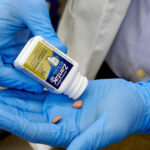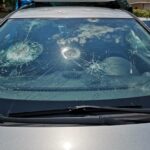Jerome Smith was just killing time at the Daughters of Utah Pioneers museum in Salt Lake City, and hadn’t planned to steal anything, he says. That was until he noticed a case filled with pocket watches and Indian War medals was not locked. So, Smith reached over the counter, opened the case and filled his pockets. He walked out of the museum and cashed in his haul at an antiques dealer for a few hundred dollars.
That was in the fall in 1993, and Smith pilfered from the museum during several other visits.
Earlier this year, the museum again fell prey to similar thefts, and some of the same rare volumes of Mormon scripture that Smith had nabbed were stolen in an after-hours burglary. The recurring thefts at the state-owned building have some people questioning the security.
“There’s some artifacts that can’t be replaced,” said Eric Pollei, a descendent of George Q. Cannon, an early leader of The Church of Jesus Christ of Latter-day Saints. “Security should be sharpened so this doesn’t happen again.”
The Pioneer Memorial Museum displays many thousands of artifacts on six floors in two buildings.The items are donated by people who want their heritage protected, said Mary Johnson, president of The International Society Daughters of Utah Pioneers.
“We are in the business of preserving history,” she said. “It is a very important museum to the state because this is where you find Utah history.”
Many of the artifacts are kept in locked glass cases, and some of the cases have alarm sensors.
Other items are kept in enclosed display rooms, while larger artifacts, such as Brigham Young’s sauna, sit behind metal fencing.
The museum has an alarm system, said Edith Menna, museum director and second vice president of the organization. She declined to say how the system worked.
Docents, usually on every floor, keep watch during the day, and the Utah Highway Patrol watches the area, too, as part of the UHP’s Capitol security detail.
“We’ve had very little, really very little problems,” Johnson said.
The security in 1993 was similar to today’s. There was an alarm system, and all the cases were locked — including the case containing the watches and medals that Smith stole, Menna said.
It had good night security, Menna said. During the day, surveillance cameras recorded onto tapes, though they did not cover every corner, she said.
“We had very good security both day or night” for that time, Menna said.
None of that security, however, stopped Smith, who stole from the museum six or seven times during business hours. He took about $500,000 worth of items, according to reports.
When cases were secured with small padlocks, Smith just twisted them off using a pair of pliers.
“They handle their history so loosely,” Smith said, adding the thefts were “a piece of cake.”
Nobody noticed the artifacts were missing until someone who had donated guns became upset the firearms were not on display, according to a report by the Utah State Bureau of Investigation, which investigated Smith’s thefts.
All the display cases were checked, and fingerprints were lifted from the one containing the pocket watches and medals.The prints came back with a match to Smith, who served more than a year for the thefts.
Following Smith’s thefts, the museum’s alarm system and security procedures were upgraded, Menna said. But Ken Sanders, owner of Ken Sanders Rare Books, said the security upgrades didn’t go far enough. He said he saw problems with the security first-hand about three years ago when he was looking at the museum’s collection of rare Mormon books.
“I was flabbergasted that there would be $1 million worth of books sitting in a glass case,” he said. “I thought it was an accident waiting to happen.”
About 11:30 p.m. on April 11, a thief broke the glass case with a hammer and took 14 books, including some Smith had stolen.
The thief entered the room after cutting a chain link fence in front of a window to the manuscript room and breaking the window with a roofing hammer through a pillow, investigators and Johnson said.
No alarms were set off. The window he broke did not have an alarm sensor on it,
Robert M. Lindsay has been charged with felony theft and burglary in that theft and also is alleged to have committed other thefts during the museum’s business hours.
The organization is upgrading the museum’s security. On the day of the break-in, security people were at the museum planning the new security system, Johnson said.
The organization had been planning the improvements for a long time and saving money for them, Johnson said.
“We have the resources now,” she said. “It will be a whole new system,” Menna said. It will be “as secure as money can do…. We’ve got the very best people working on it.”
Was this article valuable?
Here are more articles you may enjoy.

 Sanofi to Pay $100 Million to Settle Zantac Cancer Lawsuits
Sanofi to Pay $100 Million to Settle Zantac Cancer Lawsuits  South Carolina Allows Out-of-State Adjusters After Massive Hail Storm
South Carolina Allows Out-of-State Adjusters After Massive Hail Storm  Supplemental Claims Don’t Need to Include Damage Estimates, Fed Appeals Court Says
Supplemental Claims Don’t Need to Include Damage Estimates, Fed Appeals Court Says  Jury Awards $80M to 3 Former Zurich NA Employees for Wrongful Termination
Jury Awards $80M to 3 Former Zurich NA Employees for Wrongful Termination 